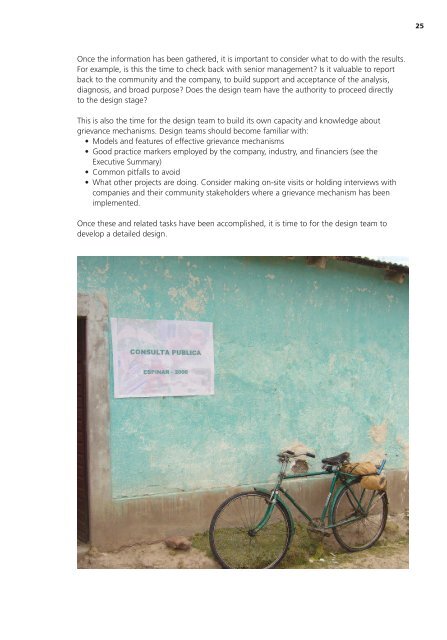A Guide to Designing and Implementing Grievance Mechanisms for ...
A Guide to Designing and Implementing Grievance Mechanisms for ...
A Guide to Designing and Implementing Grievance Mechanisms for ...
You also want an ePaper? Increase the reach of your titles
YUMPU automatically turns print PDFs into web optimized ePapers that Google loves.
Once the in<strong>for</strong>mation has been gathered, it is important <strong>to</strong> consider what <strong>to</strong> do with the results.<br />
For example, is this the time <strong>to</strong> check back with senior management? Is it valuable <strong>to</strong> report<br />
back <strong>to</strong> the community <strong>and</strong> the company, <strong>to</strong> build support <strong>and</strong> acceptance of the analysis,<br />
diagnosis, <strong>and</strong> broad purpose? Does the design team have the authority <strong>to</strong> proceed directly<br />
<strong>to</strong> the design stage?<br />
This is also the time <strong>for</strong> the design team <strong>to</strong> build its own capacity <strong>and</strong> knowledge about<br />
grievance mechanisms. Design teams should become familiar with:<br />
• Models <strong>and</strong> features of effective grievance mechanisms<br />
• Good practice markers employed by the company, industry, <strong>and</strong> financiers (see the<br />
Executive Summary)<br />
• Common pitfalls <strong>to</strong> avoid<br />
• What other projects are doing. Consider making on-site visits or holding interviews with<br />
companies <strong>and</strong> their community stakeholders where a grievance mechanism has been<br />
implemented.<br />
Once these <strong>and</strong> related tasks have been accomplished, it is time <strong>to</strong> <strong>for</strong> the design team <strong>to</strong><br />
develop a detailed design.<br />
25





